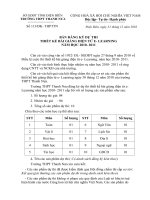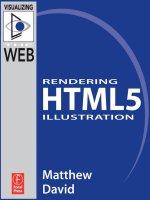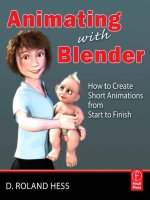Single Camera Video Production (5th e - Focal Press 2010)
Bạn đang xem bản rút gọn của tài liệu. Xem và tải ngay bản đầy đủ của tài liệu tại đây (5.41 MB, 316 trang )
Single-Camera Video
Production
FIFTH EDITION
This page intentionally left blank
Single-Camera Video
Production
FIFTH EDITION
Robert B. Musburger
AMSTERDAM • BOSTON • HEIDELBERG • LONDON
NEW YORK • OXFORD • PARIS • SAN DIEGO
SAN FRANCISCO • SINGAPORE • SYDNEY • TOKYO
Focal press is an imprint of Elsevier
Focal Press is an imprint of Elsevier
30 Corporate Drive, Suite 400, Burlington, MA 01803, USA
The Boulevard, Langford Lane, Kidlington, Oxford, OX5 1GB, UK
# 2010 Elsevier, Inc. All rights reserved.
No part of this publication may be reproduced or transmitted in any form or by any means, electronic or
mechanical, including photocopying, recording, or any information storage and retrieval system, without
permission in writing from the publisher. Details on how to seek permission, further information about the
Publisher’s permissions policies and our arrangements with organizations such as the Copyright Clearance
Center and the Copyright Licensing Agency, can be found at our website: www.elsevier.com/permissions.
This book and the individual contributions contained in it are protected under copyright by the Publisher (other
than as may be noted herein).
Notices
Knowledge and best practice in this field are constantly changing. As new research and experience broaden our
understanding, changes in research methods, professional practices, or medical treatment may become
necessary.
Practitioners and researchers must always rely on their own experience and knowledge in evaluating and using
any information, methods, compounds, or experiments described herein. In using such information or methods
they should be mindful of their own safety and the safety of others, including parties for whom they have a
professional responsibility.
To the fullest extent of the law, neither the Publisher nor the authors, contributors, or editors assume any liability
for any injury and/or damage to persons or property as a matter of product liability, negligence or otherwise, or
from any use or operation of any methods, products, instructions, or ideas contained in the material herein.
Library of Congress Cataloging-in-Publication Data
Musburger, Robert B.
Single-camera video production / Robert B. Musburger. – 5th ed.
p. cm.
Includes bibliographical references and index.
ISBN 978-0-240-81264-9 (pbk. : alk. paper) 1. Video tape recorders. 2. Video recordings–Production
and direction. 3. Camcorders. I. Title.
TK6655.V5M88 2010
778.59–dc22
2009040290
British Library Cataloguing-in-Publication Data
A catalogue record for this book is available from the British Library.
ISBN: 978-0-240-81264-9
For information on all Focal Press publications
visit our website at www.elsevierdirect.com
09 10 11 12 13 5 4 3 2 1
Printed in the United States of America
DEDICATION
To my mother, Mary Tomazina Wemple Musburger Houska, for teaching me
the value of integrating art and technology.
Contents
Introduction . xii
Additional Comments on the Fifth Edition . . . xiv
Acknowledgments . xv
Chapter One
Production Philosophy . . 2
The Production Process 2
Importance of Goals-Audience Analysis . . . 4
Importance of Workflow . . . 6
Difference between Studio and Field Production . . 8
Importance of Technology 10
Chapter Two
The Technology 12
Connecting the Real World to the Digital World 12
Limitations of Equipment 12
Audio Signals 14
Frequency . 14
Amplitude 16
Measuring Audio Signals . 18
Compression 20
Video Signals 22
Changing Light into Electrons . 22
Synchronization . . 24
Scan Systems . . 28
Measuring Video Signals . 30
Video Compression . . . 32
Chapter Three
The Equipment 34
Equipment Development . . 34
Cameras . . . 36
Camera Types . . 37
Handheld Cameras 38
HDV Professional Camera 39
Broadcast Camera . 41
Digital Cinema Camera . . . 42
Specialized Digital Cameras 43
Image Sources and Optics . . 44
Tubes 44
Chips 44
Optics 45
Focal Length 46
Focus 47
Aperture . . 48
Depth of Field 49
Viewfinder and Camera Controls . . . 50
Viewfinder . 50
Camera Controls . . 52
Bars/Gain Selector . 52
Color Temperature Control/Filter Selector 53
White Balance . . . 54
Camera Supports . . . 56
Tripods and Body Mounts . 56
Cranes, Dollies, and Pedestals . . . 58
Handholding the Camera . 60
Digital Recording . . . 63
Recording . . 63
Recorder Operation 66
Connecting Equipment 69
Cable Coiling 70
Power Connectors and Plugs 71
Audio Connectors . 72
Video Connectors . 74
Digital Connectors . 76
Audio . 78
Microphone Types . 79
Electronic Impedance 79
Element Construction 80
Pickup Pattern 82
Mounting Devices . 84
Contents vii
Nonmicrophone Audio Sources 87
Which Audio Track to Use . . . 88
Lighting 89
Floodlights 90
Focusing Spotlights . . . 92
Fixed-Focus Instruments 93
Controlling Light 95
Power Sources . 96
Color Temperature 98
Measuring Light Intensity . . . 100
Lighting Ratio . 101
Contrast Ratio . 102
Chapter Four
The Production Process: Preproduction . . 105
Preliminary Forms 106
The Proposal . . 106
Treatment 108
Legal Considerations . 112
Script Formats . . 112
Scene Script . . 112
Shooting Script 114
Script Formats . 114
Single-Column Format . 116
Dual-Column Format . . 118
Organizing Forms 120
Storyboards . . 120
Location Scouting . . . 122
Site Survey . . . 124
Organizing Equipment and Crew . . . 126
Chapter Five
The Production Process: Production 129
Production Stages and Setup . . 129
Setting Up 129
Field Equipment Considerations . . . 131
Camera Setup . 132
Contentsviii
Audio Preparation 134
Prompting Devices 136
Sets and Properties . . . 138
Lighting Preparation 140
Controlling Color Temperature . 142
Controlling Light Intensity 144
Contrast Range . 146
Basic Three-Point Lighting 148
Backlight 148
Key Light 149
Fill Light . 149
Kicker and Set Lights . . 150
Multiple or Moving Subjects . . 152
Creative Lighting 154
Mood Lighting . . 154
Lighting for Time, Date, and Location . 154
Directing and Rehearsing . 156
Directing Talent . 156
Rehearsal 157
Shooting . . 160
Shooting and Framing . . 162
Standard Shot Names . 163
Framing Principles . 166
Aspect Ratio . . . 166
Critical Area . . . 168
Lead Room or Edge Attraction . 169
The Rule of Thirds 170
Creating Movement 172
Subject Movement 172
Camera Movement 174
Movement through Zooms 174
Z-Axis Movement 176
Graphic Force Movement 178
The Third Movement: Editing . . . 181
Shoot to Edit . . 181
Continuity of Action . . . 182
Continuity of Direction . 182
Contents ix
Continuity of Location . 183
Cover Shots . . 184
In-Camera Effects 186
Iris Fades 186
Roll or Rack Focus . . . 187
Swish Pans and Zooms 187
Reversing Polarity . . . 188
Digital In-Camera Effects 188
Logging and Striking . . . 190
Striking 192
Chapter Six
The Production Process: Postproduction . 195
The Soul of Production . . 195
Editing Depends on Aesthetic and Equipment Knowledge and Skills 196
Editing Concept . 198
Basic Process . 198
Process Background 200
Nonlinear Film . 200
Linear Electronic 202
Nonlinear Electronic . . 204
Hardware . 206
Editing Equipment . . . 206
Accessories . . . 208
Software . 210
Physical Process . 211
Choices and Decisions 211
Technical Process 216
Editing Operating Methods . . 220
Basic Editing . . 221
Transitions . . . 222
Titles . . 224
Adding Audio . 225
Rendering 226
The Aesthetic Process . . 228
Output-Distribution 233
Preparing to Output/Export . . 233
Contentsx
Output Process . 234
Destination Choices . . . 236
Chapter Seven
Your Future . . 237
Introduction 237
Internship . 240
The Application Process . . 242
Re
´
sume
´
Writing . . 243
Composing a Cover Letter . 243
The Portfolio 246
The Interview 248
Summary . . 250
Glossary . . . 253
Further Reading . . . 287
Index . . 289
Contents xi
Introduction
This text has been written to provide three groups of video enthusiasts with enough
information to produce acceptable single-camera video productions: the media produc-
tion student, the professional who needs a refresher on the basics, and the first-time
video camera owner. It is a basic, introductory book designed to point the beginner in
the right direction. This is not an advanced book in preproduction research and
writing, nor is it a book on advanced techniques in electronic editing. Each of those
subjects deserves its own title.
I wrote this book from three points of view: first, from that of an instructor introducing
the techniques that lead to quality video productions utilizing a single video camera;
second, from that of a practitioner who has spent 50 years working in professional
media and learning the contents of this book the hard way—by making mistakes until
I finally got it right; and third, from that of an academic fielding 20 phone calls a week
from people new to electronic production who desperately want information about
single-camera video production.
This book outlines the process of working with a single video camera from beginning
to end, with an emphasis on the actual production process. First, though, you must lay
some groundwork before you pick up your camera. The video camera and the record-
ing medium used remain two complex pieces of equipment, despite efforts to simplify
them. The process by which a video image is created is also complex, and you must
understand it in order to properly utilize the benefits and master the restrictions of the
medium.
The first chapter of the book outlines the production process, emphasizes the impor-
tance of goals and audience analysis, explains the production workflow process, and
discusses the importance of technology. The second chapter contains a simplified
explanation of how and why video and audio signals are created. It also describes
the technical restrictions of a digital system. The third chapter describes the equip-
ment: cameras; recorders; and audio, lighting, and mounting equipment. With the first
three chapters providing a firm base, the fourth chapter carries you through the
production process from preproduction planning (much more important than most
beginners realize) to setting up, rehearsing, shooting, and striking. The fifth chapter
details the digital process by exploring lighting and audio techniques. The sixth
chapter concentrates on the digital nonlinear editing process, techniques, aesthetics,
and the importance of shooting for the editing process. The final chapter outlines
methods to move your career beyond the classroom: finding and earning an internship,
preparing for the interviewing and job search process, and approaching your first and
next job.
As the media production world rapidly moves toward an all-digital environment, I have
included those changes that are critical for single-camera production. From experi-
ence, I am aware that the rapid changes require new information on virtually a weekly
basis. I have attempted to anticipate some of those changes, but at the same time,
I have avoided making any wild guesses as to the next level of production develop-
ments. There are too many new concepts and proposals in the works—some of them
will be working years from now, others will be gone within 6 months. All we can do is
watch, take advantage of what the field has to offer, and remember that it isn’t the
paintbrush that makes the difference, it’s the mind and the hands of the artist.
Introduction xiii
Additional Comments on the
Fifth Edition
The layout of this text includes major changes from the old format, in which editorial
copy was placed on one page with illustrations on the facing page. In the new format
presented here, figures and photographs are interspersed with the editorial copy as
needed to illustrate or clarify a point. More than 100 new figures and photographs
replace drawn figures.
The emphasis will expand on the concentration of digital equipment and production
techniques applicable to field video production and nonlinear postproduction. New
sections on production workflow, audience analysis, modern formats, distribution
methods, and career planning extend the value of this book.
A key factor in the move of media to an “all-digital” production format is the realiza-
tion that all media must start in an analog format, and for humans to comprehend the
messages, the messages must be returned to an analog format. Media converted to a
digital format may be easily manipulated without loss of quality but cannot be viewed
or listened to until converted into a form a person’s eye and ear can interpret. For that
reason, some analog theory and technology remain as critical parts of this book and
will remain so until humans can directly interpret a digital signal.
Acknowledgments
One cannot work in the video business without relying on many other people. This is
not a solitary business, and throughout the years many people have made major con-
tributions to my knowledge and career. Here are a few of many: Parks Whitmer and
Sam Scott, who started me in media production and kept me going; Art Mosby, who
paid my first television paycheck; Bob Wormington, who let me develop my directing
skills; the thousands of students at Avila College, University of Missouri at Kansas
City, Kansas University, Florida State University, the University of Houston, and Central
Washington University who constantly reminded me that I don’t know everything there
is to know about media production; and my wife, Pat, who lets me think that I do.
Credit for the illustrations for this book I share with more than 30 manufacturers of
equipment who provided photographs, ideas, and illustrations for this text. Thanks
also to all of the helpful people at Focal Press who have guided and prodded me
through my publishing efforts for the past 19 years: Karen, Philip, Mary, Trish, Marie,
Maura, Tammy, Tricia, Lilly, Jennifer, Amy, Elinor, Cara, and, for this edition, Michele
Cronin and Laura Aberle.
This page intentionally left blank
Chapter One
Production Philosophy
The Production Process
Despite the general public’s attitude toward digital media production as a simple activity,
in reality you will find that although digitizing has made the equipment lighter, smaller,
more powerful, and full of technology that offers greater creativity to you as a producer,
director, camera operator, or editor, the process actually has gotten more complex.
When you replace controls and functions necessary to operate analog video and audio
equipment with digital equipment, it appears to make operations simpler, and in some
ways that has occurred. But the nature of digital technology and equipment provides
you a greater opportunity for more choices in operations. Those opportunities require
you to meet a broader range of decisions, setting specific operational criteria for each
shot or setup. You may point and shoot, but that alone is not professional.
To give you the best means to take advantage of all that digital equipment offers, this
text is organized to lead you through the entire production process from beginning to
end. The first step is for you to understand that production is actually a three-stage
process: preproduction, production, and postproduction. The three stages are unique
and separate to a point, but they are dependent on each other for the success of
the complete project, and all are also dependent on the final plans for distribution
of the project. The three steps are equally important—without all three you will
not be able to complete a professional production (see
Figure 1.1).
You will use the preproduction stage to prepare the production, organize and research
your thoughts on what you want to do with it, and complete the many sets of written
materials from proposals through completed scripts.
During the production stage before you actually start shooting, you still must perform some
preparation steps before you may remove the lens cap and record data. You must take as
much care with logging and striking equipment as you did with setting and shooting.
Once the data are recorded on tape, disc, or solid-state media, you then are faced
with organizing the material again in the postproduction stage. Data must be entered,
and you must choose the shots you want and trim them into a final form before add-
ing sound, effects, and completing your final project.
Single-Camera Video Production2
SINGLE-CAMERA VIDEO PRODUCTION
THREE-STEP PRODUCTION PROCESS
PREPRODUCTION PRODUCTION
POSTPRODUCTION
Concept
Research
Planning
Organizing
Crew
Cast
Equipment
Acquisition
Organizing
Constructing
Sets
Props
Communication
Prompting
Ingesting
Logging
Formatting
Draft Script
Scene Script
Shot Script
Setting up
Lights
Audio
Camera(s)
Rough Cut
Final Cut
Audio Mix
Location Scouting
Site Survey
Plot Drafting
Rehearsal
Rough
Cast
Camera
Final
Effects
Color Correction
Audio Correction
Rendering
Hiring
Crew
Cast
Equipment
Recording
Logging
Effects
Striking
Master
Release
Output
Proposal
Treatment
Budget
Storyboard
FIG. 1.1 – Depending on the requirements of the individual production, the size of the crew, and the
length of the production, some of the functions and operations of each of the three steps may be
combined or completed simultaneously.
The Production Process
Chapter One | Production Philosophy 3
Importance of Goals-Audience Analysis
Before you commit yourself to a project, you ought to seriously consider what you
have decided your goals must be to achieve your objective. You must work toward
illustrating your concept accurately and as you have envisioned it in your own mind.
Your project has little chance of success unless you have developed a story that will
attract and hold an audience. As much as you may want to produce a project for your
own enjoyment, there is no value in such a project unless someone else is interested
in viewing it and understanding your message and unless it stands as an example of
your ability to create a professional quality production (see Figure 1.2).
PRODUCTION GOALS-OBJECTIVES
GOALS OBJECTIVES
Fulfill Personal Vision
Tell a Compelling Story
Create a Professional Production
Attract a Funding Source
Attract an Audience
Establish Professional Qualifications
FIG. 1.2 – Among the six key characteristics of a professional production are fulfilling a vision and
telling a story that will establish your professional qualifications by attracting funding and an
audience.
Single-Camera Video Production4
You may be able to produce a short using the equipment made available to you by
your employer or school, but as a professional you must learn to create a concept that
organizations or individuals will believe in enough to provide the funds that will allow
you to complete the project. One aspect of what determines a funding source’s deci-
sion is your convincing the organization that a large enough audience would be inter-
ested in the project to make the investment worthwhile. As producer, you must
understand how to analyze audiences and how to create a production that will maxi-
mize the size of that audience.
Importance of Goals-Audience Analysis
Chapter One | Production Philosophy 5
Importance of Workflow
The process of moving video and audio signals in digital formats from one stage to
another is now called workflow. As your production moves away from tape and even
disc recording systems, solid-state devices allow digital audio and video signals to be
handled as a data-digital, ones and zeros, not actual audio or video signals. Because
the media signals are in the form of data signals, you may more easily move, manip-
ulate, store, and transfer the data quickly from one location to another and to do it
simultaneously. This allows you and others to edit, review, and manage a production
at the same time. Such a workflow process makes broadcast news and multieditor
postproduction facilities efficient operations (see Figure 1.3).
WORKFLOW SYSTEMS
Source Ingest Log/Edit Finish Distribute
Storage
OPEN
Source
Distribute
Finish
Log/Edit
Ingest
Storage
LINEAR
FIG. 1.3 – As workflow becomes a practical and widespread concept, different methods of using the
system have developed. The two most common are the original linear, straight-through system and
the more flexible system used in news operations, the open system.
Single-Camera Video Production6
This page intentionally left blank
Difference between Studio and Field Production
One of the first choices you will need to make once you have developed, researched,
and found funding for your project is to decide whether to produce it in a studio or in
the field. You will face advantages and disadvantages in either location (see Figure 1.4).
A studio production offers you the protection and control over all aspects of sound,
lighting, personnel, and equipment. Once you design and construct the set, it is a
known factor for which lighting can be designed to work for you. A soundproof studio
guarantees you the best possible sound while shooting. The entire production, cast,
you, and crew will have a set and a known location to begin each day’s shooting.
All equipment and other facilities will be secured and present when you need them
on schedule without interference from any outside crowds or uncontrolled weather.
A studio may restrict your actions and scenes to what can be constructed or is avail-
able between the studio walls and facilities. Your budget must include the daily cost
of the studio and facilities.
Shooting in the field offers you creative flexibility in choosing a precise, realistic
setting that cannot be reproduced easily in the studio, such as shooting on the side
LOCATION CHOICES
STUDIO FIELD
Control Light Realistic Environment
Control Sound Unrestricted Movement
Control Environment Subjects Unavailable in Studio
Single Location Flexibility of Movement
Secure Equipment Difficult to Reproduce Environment
Protected Cast and Crew Impossible to Reproduce Environment
FIG. 1.4 – In many cases, the advantage of working in a studio may be the disadvantage of working in
the field: controlled sound in the studio, less control of sound in the field. But advantages in one
location may be offset by advantages in another location.
Single-Camera Video Production8
of the Grand Canyon. You may not be able to move some subjects or objects to a studio
setting, and these are best shot in their natural environments. Obviously you can only
shoot news and many documentary subjects in the field, and the disadvantages of field
shooting must be overcome by your careful and creative production planning. Despite
the wide-ranging ability of digital postproduction techniques to allow you to duplicate
settings and situations not available in the studio, shooting on location adds a touch of
empathy that cannot be created digitally.
Difference between Studio and Field Production
Chapter One | Production Philosophy 9









